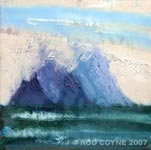May 17th - July 19th 2007
"Kerry Dawn, Wicklow Dusk"
View Paintings >
Opening Night >
Webdesign: Anja Coyne www.anjacoyne.com

"To Skellig"
Rod Coyne, 2007, oil on canvas, 40 x 40 cm
I will never forget seeing Rod Coyne one March, intermittently ankle-knee deep in the surf at St. Finian's Bay, working behind an easel weighted by a rock on a string, trying to nail down the far off Skelligs before the tide took him and his painting away. In two minutes the fog that comes and goes could obscure the fabled peaks in the tantalizing distance. His brush was flying across the canvas, waves of Prussian blue matching the distant water, then blasts of white to catch the surf, before it caught him, acute black angles for the islands. He was knee deep in his element as he waded back to shore like a fisherman, hell, smiling like Peter - before he was a saint - but with the catch of the day in hand.
One of the experiences we like to get out of an artist is to see and to feel with his eyes and his heart. The Meeting of the Waters triptych carries us into the heart of the Avoca Valley. The mangled paint, textured by some mysterious technique, transports the viewer inside the valley, inside Rod's fingertips. The physicality of the paint on the canvas is more palpable than the mist rising off the river - and as ethereal as that mist too. The random bits and bobs of leaf, sprig, and dirt are the result of the canvas flopping to the Avocan ground while drying. Even a boisterous wind is a creative ally for this artist clearly under the influence of his Irish home-ground.
Traditionally, as in Wordsworth and Coleridge, the poet, read here artist, has two jobs: render the quotidian in its unnoticed but startling beauty (Wordsworth's domain). Or: fetch the truly exotic and communicate it to the locals (Coleridge on a good strange day.) Rod Coyne catches the real daily beauty of Ireland by being there, by witnessing the change of sundawn light down in Cill Rialaig or sunset down in Wicklow. But seeing the Irish light is not necessarily believing in it, because its fleeting delicacy and knock down punch removes us from ordinary perception. Rod amplifies such moments on canvas by bringing all of himself to the daunting task of looking into and out of the sun and then translating that sublime experience into color and form. I do not buy these perceptions as unreal. Furthermore, the reality comes through the paint, and even Rod could not make it up.
James Bogan
Distinguished Teaching Professor- Art
University of Missouri-Rolla / USA